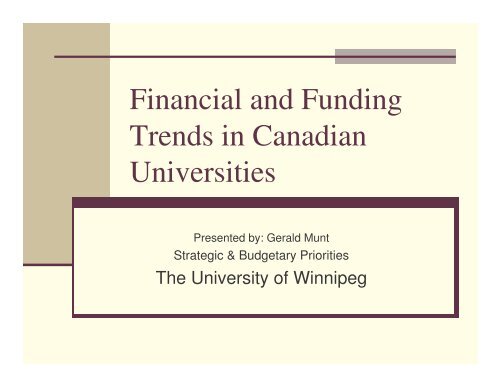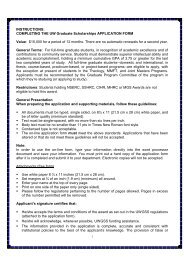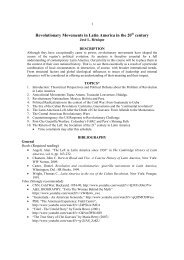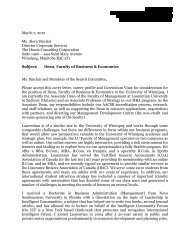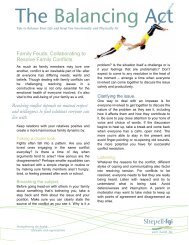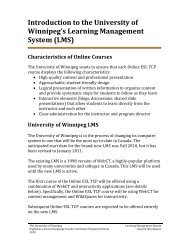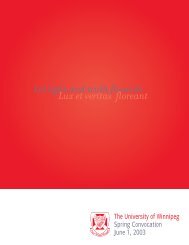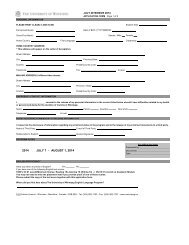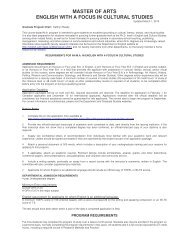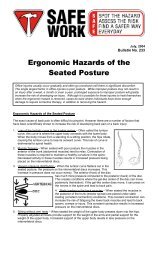Gerald Munt - University of Winnipeg
Gerald Munt - University of Winnipeg
Gerald Munt - University of Winnipeg
Create successful ePaper yourself
Turn your PDF publications into a flip-book with our unique Google optimized e-Paper software.
Financial and Funding<br />
Trends in Canadian<br />
Universities<br />
Presented by: <strong>Gerald</strong> <strong>Munt</strong><br />
Strategic & Budgetary Priorities<br />
The <strong>University</strong> <strong>of</strong> <strong>Winnipeg</strong>
Areas to address<br />
The long-term funding changes<br />
Tuition as a strategic driver<br />
The access story<br />
The meltdown and its aftermath
The Funding Changes<br />
Up to to 1996-8 – Education costs shared with<br />
Federal government - substantial operating funding<br />
1996 to 2004 Provinces cut back as federal revenues<br />
reduced – dramatic tuition increases<br />
2004 to present – federal increases in research funds<br />
– provincial increase in operating combined with<br />
limitations in tuition increases<br />
2009 plus – Decline in endowments – Probable future<br />
decline in federal and provincial funds
Despite recent increases in government funding, rapid enrolment growth and<br />
inflationary pressures have resulted in universities having significantly less<br />
resources to support teaching, learning and research than in the 1980s and<br />
most <strong>of</strong> the 1990s<br />
Revenues per FTE student in constant 2006-07 $<br />
$21,000<br />
$18,000<br />
$15,000<br />
$12,000<br />
$9,000<br />
$6,000<br />
$3,000<br />
$0<br />
1980-81<br />
1982-83<br />
Sub-total (net) general operating and special<br />
purposes and trust revenues<br />
Government<br />
Student fees net <strong>of</strong> scholarships<br />
Gifts, donations and investment income<br />
1984-85<br />
1986-87<br />
1988-89<br />
1990-91<br />
1992-93<br />
1994-95<br />
1996-97<br />
1998-99<br />
Source: AUCC using data from Statistics Canada. Thanks to Herb O’Heron<br />
2000-01<br />
2002-03<br />
2004-05<br />
2006-07<br />
Deflator based on the U.S. Higher Education Price Index
Federal Cash Transfers for Post-Secondary<br />
Education (% <strong>of</strong> GDP)<br />
0.6<br />
0.5<br />
0.5<br />
0.44<br />
0.44<br />
0.4<br />
0.3<br />
0.2<br />
0.33<br />
0.29<br />
0.19<br />
0.23<br />
0.15 0.16<br />
0.1<br />
0<br />
1983-<br />
84<br />
1986-<br />
87<br />
1989-<br />
90<br />
1992-<br />
93<br />
1995-<br />
96<br />
1999-<br />
00<br />
2001-<br />
02<br />
2004-<br />
05<br />
2007-<br />
08<br />
Source: CAUT Almanac 2008-09 based on Stats Canada Data
Provincial Responses Varied<br />
Slide from CAUT Almanac 2008-09
First Impact – Higher Tuition<br />
100.0%<br />
80.0%<br />
60.0%<br />
40.0%<br />
20.0%<br />
0.0%<br />
1976 1986 1996 2006<br />
0ther 3.6% 4.7% 7.1% 14.3%<br />
Tuition 13.2% 14.2% 22.4% 29.2%<br />
Government Funding 83.2% 81.1% 70.5% 56.5%<br />
Source: CAUT Almanac 2008-09
Increased Tuition Impact<br />
<br />
<br />
<br />
<br />
<br />
Competition for students<br />
Enrolment Strategy and Management<br />
Greater focus on recruitment and retention<br />
MacLean’s and Globe and Mail as marketing tools<br />
Expansion <strong>of</strong> scholarships and bursaries<br />
Two and three-tiered tuition<br />
Endowments grew to fund support<br />
Gifts and donations grew from $90 M to $250 M between<br />
1990 and 2004 (Source: AUCC Trends)<br />
Some provinces have matching fund programs<br />
More support for individuals<br />
Tax expenditures<br />
Student loans<br />
Tuition freezes and controls
Differences in population change will continue to drive<br />
much different enrolment demand in different parts <strong>of</strong><br />
Canada<br />
B.C. - C.-B.<br />
Alta. - Alb.<br />
Sask.<br />
Man.<br />
Ont.<br />
Que. - Qc<br />
N.B. - N.-B.<br />
N.S. - N.-É.<br />
P.E.I. - Î.-P.-É.<br />
Will impact recruitment costs<br />
in different ways as well<br />
N.L. - T.-N.-L.<br />
CANADA<br />
70% 80% 90% 100% 110%<br />
Medium growth scenario Population change age 18 to 21 2008 to 2018<br />
Statistics Canada<br />
Thanks to Herb O’Heron and AUCC
Enrolment Strategies mean new<br />
Target Groups<br />
Higher revenue<br />
International<br />
Inter-provincial<br />
Executive seminars<br />
Groups not currently major focus<br />
Adult Learners<br />
New Canadians<br />
Groups with significant barriers<br />
Low income<br />
Aboriginal
Some impact so far<br />
Disability<br />
Visible Minority<br />
Aboriginal<br />
International<br />
2002<br />
5%<br />
14%<br />
3%<br />
5%<br />
2008<br />
8%<br />
19%<br />
3%<br />
6%<br />
Source: CUSC Survey
Low Income/Aboriginal<br />
Proportion <strong>of</strong> Canadians Aged 18 to 21 Accessing<br />
Post-secondary Education by Income Quartile<br />
50%<br />
40%<br />
30%<br />
20%<br />
10%<br />
39%<br />
29% 29% 28% 28% 28%<br />
24%<br />
19%<br />
College<br />
<strong>University</strong><br />
0%<br />
Lowest Lower Middle Upper Middle Highest<br />
Source: Statistics Canada’s Survey <strong>of</strong> Labour and Income Dynamics as cited in “The<br />
Price <strong>of</strong> Knowledge” 2004 (Canada Millennium Scholarship Foundation)
Minimal Improvement to Date<br />
<br />
“[A]lthough participation rates grew for children <strong>of</strong> all<br />
backgrounds from 1976 to 1994, the participation gap between<br />
poor and middle-income groups also grew during the same<br />
period.” (AUCC Trends)<br />
<br />
“the rate <strong>of</strong> university attendance is about two times greater for<br />
youths from high income families (over $100,000) compared to<br />
youths from the lowest income families throughout 1993 and<br />
2001.” (Marie Drolet)<br />
<br />
Similar experience in Manitoba. A survey, using geography<br />
based on postal codes, showed minimal change for Low SES<br />
students between 1998-9 and 2003-4
It’s more than Finances<br />
Affordability is only one element influencing access.<br />
Tuition Fees are only one element <strong>of</strong> affordability<br />
“Differences in long-term factors such as standardized test<br />
scores in reading obtained at age 15, school marks reported<br />
at age 15, parental influences, and high-school quality<br />
account for 84% <strong>of</strong> the gap. In contrast, only 12% <strong>of</strong> the<br />
gap is related to financial constraints.” (Marc Frenette)<br />
“about the same proportion <strong>of</strong> Aboriginal high school<br />
graduates is going on to graduate in some form <strong>of</strong> PSE as<br />
high school graduates in the general population.” Michael<br />
Mendelson
Increasing Access means either greater<br />
supports or higher turnover<br />
Child care, transportation, housing, and other<br />
infrastructure<br />
Extended admin hours<br />
Transition programs<br />
Pedagogical changes
Other Impacts<br />
Faculty growth not keeping pace with<br />
enrolment growth<br />
Expanded role <strong>of</strong> investment return in overall<br />
strategy<br />
Deferred maintenance
Faculty numbers have expanded by 23 percent between 1997 and 2007 but<br />
still trail well behind the 37 percent growth in full-time enrolment over the<br />
same period<br />
Index 1976=100<br />
225<br />
200<br />
175<br />
150<br />
125<br />
100<br />
75<br />
50<br />
25<br />
0<br />
1955<br />
1958<br />
Full-time faculty<br />
Full-time students<br />
Expansion<br />
From 6,000<br />
To 30,000<br />
1961<br />
1964<br />
1967<br />
1970<br />
1973<br />
1976<br />
Funding<br />
enrolment<br />
growth with<br />
marginal<br />
revenues<br />
1979<br />
1982<br />
1985<br />
1988<br />
1991<br />
1994<br />
Source: Statistics Canada data and AUCC estimates<br />
Thanks to Herb O’Heron and AUCC<br />
Mid -<br />
1990s<br />
funding<br />
cuts<br />
Reinvestment<br />
1997<br />
2000<br />
2003<br />
2006e
2004-2009 Enhanced Government<br />
Support<br />
Increased faster than:<br />
Student growth<br />
Government spending as a whole<br />
K-12 education<br />
Health expenditures<br />
Source: On the Brink – Alex Usher and Ryan Dunn
The Double Impact <strong>of</strong> Current<br />
Recession<br />
Stock market influence on endowments,<br />
pension funds and salary costs.<br />
Probable funding cutbacks either during<br />
recession or, more likely, as the economy<br />
recovers and governments cut spending to<br />
balance their budgets
Impact <strong>of</strong> Market Decline<br />
Reduce Endowments<br />
Scholarships and Bursaries<br />
Reduce Pension Assets (means increased<br />
operating costs<br />
Delay retirements<br />
Especially for faculty/staff who are in money<br />
purchase plans or who planned to supplement<br />
their pensions with private savings
Endowments<br />
Currently $10 billion for Canada as a whole<br />
Highly concentrated<br />
U <strong>of</strong> T = 25%<br />
Top four (UBC, McGill, U <strong>of</strong> A) equals 50%<br />
Most revenues are restricted<br />
Required to withdraw 3.5% <strong>of</strong> average assets<br />
which is actually more when applied to<br />
current principal.<br />
Source: On the Brink
Impact <strong>of</strong> Recession<br />
Government revenues will be hurt<br />
Effects their ability to maintain expenditures<br />
More likely to be immediate in provinces with<br />
balanced budget commitments/legislation<br />
Otherwise delayed until economy recovers<br />
and Governments reduce expenditures to rebalance<br />
budgets<br />
Will have some enrolment increases
Questions<br />
Is this a short-term or long-term problem?<br />
Hunker down or get active?<br />
According to AUCC 8 out <strong>of</strong> ten provinces have some<br />
form <strong>of</strong> tuition control. If funding cutbacks are coming<br />
are requests for major tuition increases far behind?<br />
70% <strong>of</strong> university operating costs are staffing related.<br />
How do universities adjust to sharp declines in<br />
revenue when cost increases are far less adaptable?


